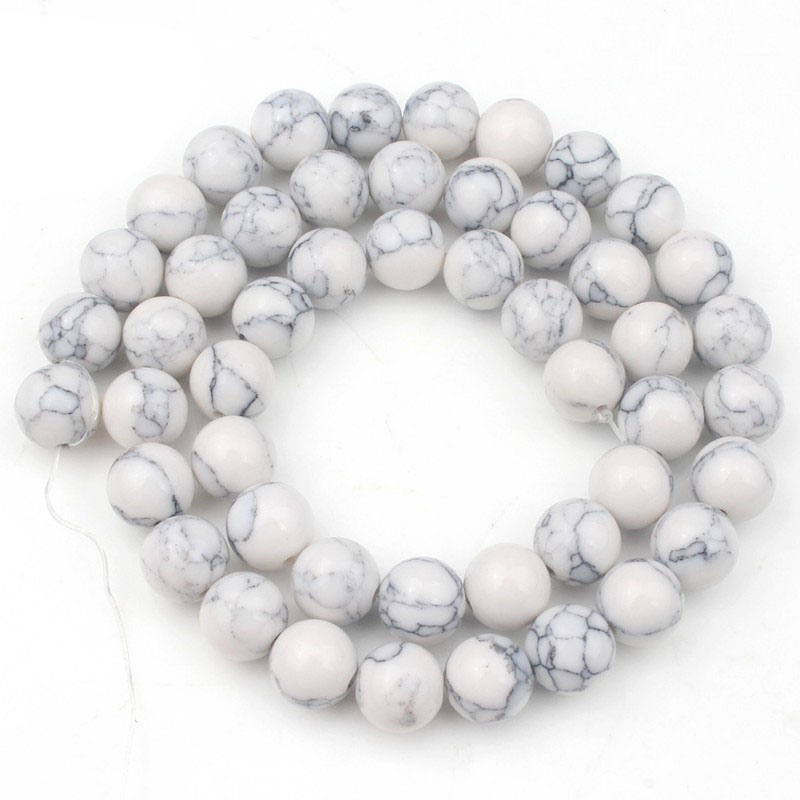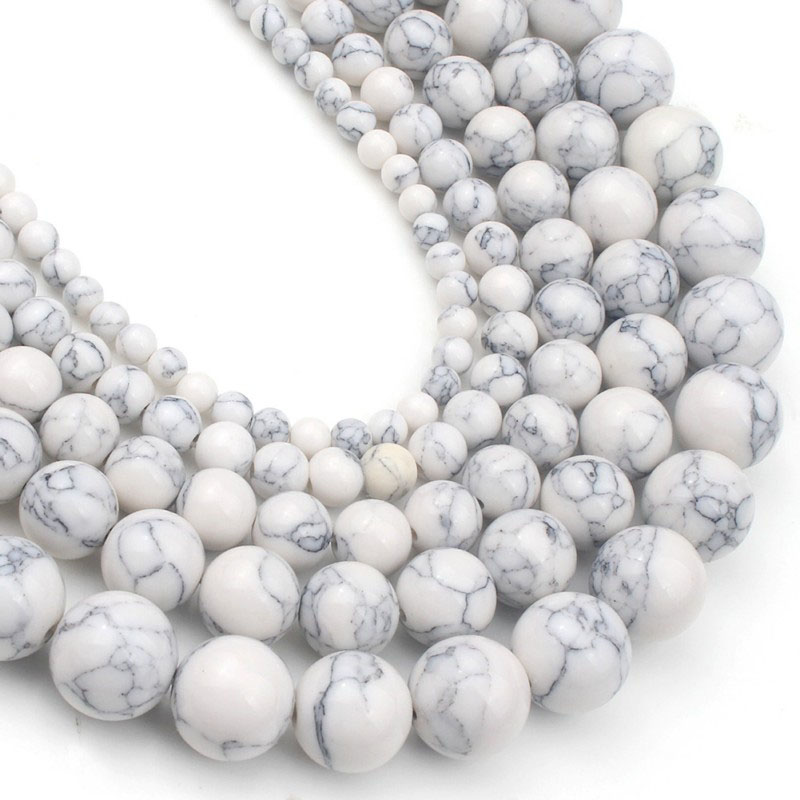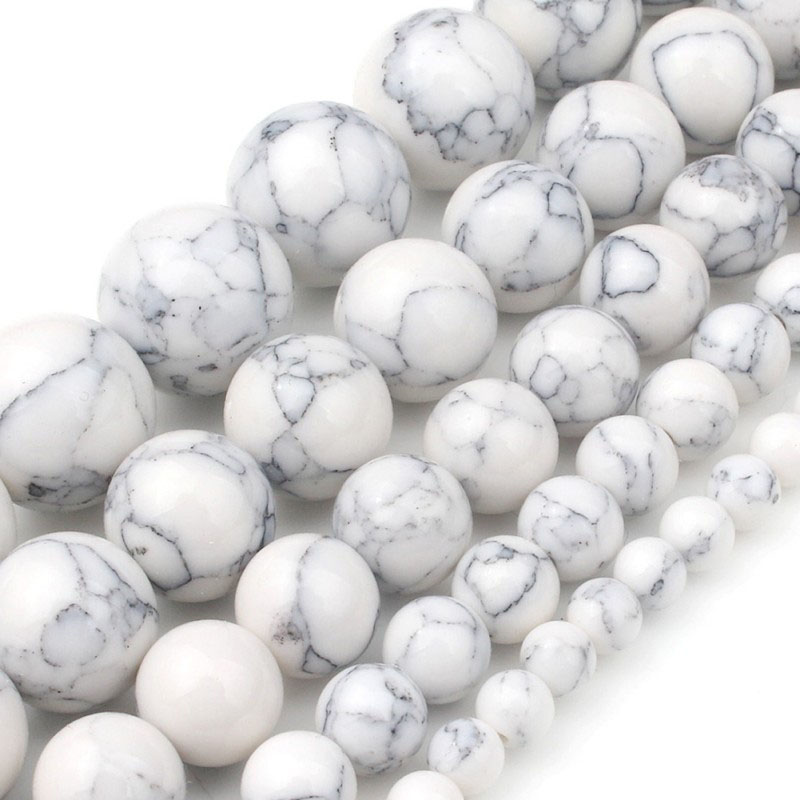Howlite is a white and sometimes containing black mineral with delicate veins. Although the hardness of Howlite is very low, it can withstand polishing and is often used as a decorative gem or as an imitation of turquoise.
Basic property of Howlite
- Chemical composition: Ca2 [B4BSiO9 (OH) 5].
- Crystal system and crystallization habit: monoclinic system, plate-like crystal, often in the form of massive aggregate.
- Color: white, gray white, often with dark gray and black veins.
- Gloss and transparency: glass luster; Translucent – to opaque.
- Optical property: The negative optical property of biaxial crystal is often a heterogeneous aggregate.
- Refractive index and birefringence: the refractive index is 1.586~1.605 (± 0.003), and the spot measurement is usually 1.59;
- The birefringence is 0.019.
- Pleochroism: None.
- Fluorescence: brown-yellow under long-wave ultraviolet; It is weak to medium and orange under short-wave ultraviolet.10) Absorption spectrum: not characteristic.
- Cleavage and fracture: None.
- Mohs hardness: 3~4.
- Density: 2.58 (-0.13) g/cm.
- Enlarged examination: dark gray or black spider web veins can be seen.

What is Howlite
Howlite has a chemical composition of Ca2 [B4BSiO9 (OH) 5]. It belongs to the monoclinic system, ao=12.78, bo=9.33, co=8.60A; B=104°50', Z=4. Spectral lines of main powder crystals: 4.14 (100), 6.24 (90), 3.10 (75). Monocrystals are plate-like but rare, usually lumpy or lumpy aggregates.
It is white in color and sometimes blue, like turquoise. It is glassy, slightly transparent to translucent. The fracture surface is flat and porcelain-clay-like. The hardness is 3.5-4, and the density is 2.45-2.58g/cm3.
It can emit brown-yellow fluorescence Under ultraviolet short wave irradiation and can emit dark orange fluorescence under long wave irradiation, Colorless under transmitted light.
Biaxial crystal, negative light, large optical axis angle.
Refractive index: Ng1.605, Nm1.596-1.598, Np1.583-1.586.
Birefringence 0.022.
In terms of arts and crafts, its blocks are required to be dense, tough, large, and blue. If the color is very light, it can be used as a substitute for turquoise after being dyed blue.
How to identify Howlite
If Howlite is made with Blue dye materials, it can be faked as turquoise or imitation lapis lazuli. Howlite can be eroded by hydrochloric acid, but turquoise cannot. The dyed Howlite is pink when observed through the Charles filter, while turquoise and lapis lazuli is not.
The dyed light Howlite often has uneven color distribution and is concentrated in the gap, which will fade for a long time.

Where is Howlite from?
The Howlite in the crust is mainly produced in salt lakes or borate deposits and coexists with gypsum, anhydrite, Meyerhofferite, etc.
Gem-grade Howlite is mainly produced in the United States. For example, the Howlite in California weighs hundreds of pounds. In addition, it is also produced in Novascotia, eastern Canada, and it is produced as small nodules together with ulexite.
Howlite variant
Colemanite
Colemanite is a kind of hydrous calcium borate mineral.
- Chemical formula: Ca2B6O11 ・ 5H20.
- Monocline system,
- The crystals are short columnar, biconical, more common granular and spherical aggregates;
- Colorless transparent or milky-white light-yellow, glass luster;
- Biaxial normal crystal,+2V=55 ° or so;
- Refractive index Ng=1.614, Nm=1.592,Np=1.586;
- birefringence 0.028;
- Light yellow or light green fluorescence can be seen under short-wave ultraviolet light, and some can also see phosphorescence.
- the hardness of 4.5,
- relative density of 2.42~2.44,
- Cleavage parallel (010) complete.
It is mainly produced in gypsum salt deposits and also in hot spring sediments. High-quality crystals come from death valley, California. (there are 50-100 carats of large crystals). Other places of origin include Nevada, Russia, Türkiye, and Argentina.
Datolite
Datolite is a kind of hydroxy silicate calcium mineral.
- Chemical formula CaBSiO4 (OH),
- the monoclinic system, short columnar crystal, common dense block, or particle Shape aggregate;
- Colorless and transparent, or light yellow, light green, pink brown, white and other colors;
- Glass luster, biaxial negative crystal, 2V=75 °;
- Refractive index Ng=1.666~1.670, Nm=1.649~1.658. Np=1.622~1.626; birefringence:0.044~0.047; Dispersion 0.016.
- The hardness is 5~5.5,
- the relative density is 2.9~3.0, and there is no cleavage.
It occurs in dikes and cavities of basic igneous rocks. High-quality crystals are produced in Habachtal in the Austrian Alps and in Massachusetts in the United States. In addition, it is also produced in New Jersey in the United States and Cornwall in the United Kingdom. It can be ground into turned gemstones.

How to Optimize Howlite
It is easy to dye and can be dyed into green (imitating turquoise), blue (imitating lapis lazuli), and other colors. The color is not naturally distributed, concentrated in the vein, and will fade. Pink or red under the color filter.
Howlite Healing Property
Howlite belongs to a monoclinic healing stone, which can transform negative energy. It can help us focus on our bright side, deeply understand our strengths and positive characteristics, and discover our potential.
It contains a lot of calcium, which can help us relax, remove tired corners and energy blockages caused by long-term sports injuries, and help us recover.
How to use
If you can carry the Howlite with you, you can keep modest at any time and understand that your real advantages are not talents recognized by others but good qualities that can really make you happy.
In the face of those who are arrogant or unwilling to face their own problems, they can also use the power of the white tattoo stone to transform bad habits.
When to use Howlite
- When you feel that others are inferior to me
- Hopes to deeply understand their potential and advantages
- desires to obtain pure energy
How to clean Howlite
√: fragrance, smoke, crystal hole, sound.
×: Sunlight, sea salt, and flowing water can all cause crystal damage
Conclusion:
Howlite is a kind of opaque white ore and sometimes contains black reticular stripes. It was founded in Canada in 1868 by Henry, a chemist, geologist, and mineralogist.
The nature of the Howlite is similar to that of clay, and it is very easy to dye or color, so it is often used to counterfeit lapis lazuli, turquoise, and Charoite crystal.
